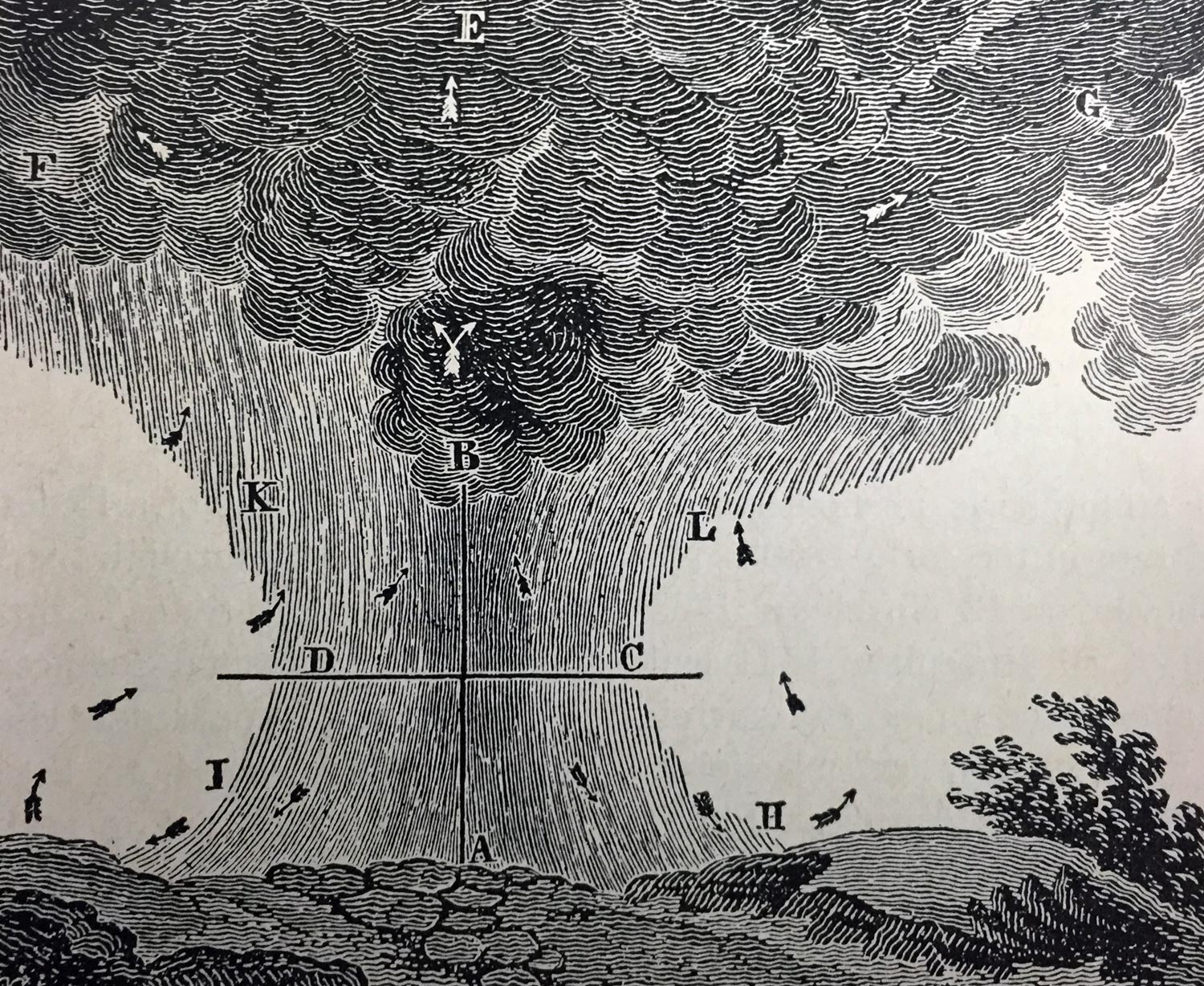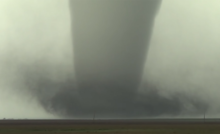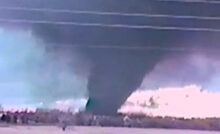New Jersey’s deadliest twister and the first scientific tornado study in the United States


An early diagram of storm motion by James Espy. (Early American Tornadoes)

Even though most think of tornadoes as largely residing in the central United States, much of the early American history of these whirlwinds comes from the territories of the first colonies. That’s an area encompassing present day New England, southward along the eastern seaboard toward today’s Georgia.
Tornado studies and surveys are commonplace now. Projects like the various iterations of VORTEX and numerous smaller ones have brought a wealth of knowledge to the current discussion. Additionally, well over 1,000 tornadoes are rated in an average year across the country. The ratings, which are based on “damage indicators” that estimate a tornado’s wind speeds, are done by government officials from over 100 National Weather Service offices.
While examples of mass destruction and various observations came from a growing number of tornadoes by the early 1800s, a major scientific study of a tornado site did not occur until 1835*, when a significant tornado hit New Brunswick, New Jersey. The storm devastated the town and others in the area. It left five dead and is still New Jersey’s deadliest tornado on record.
The account of that study is detailed in David Ludlum’s Early American Tornadoes (AMS, 1970) and reproduced below, as is a synopsis of the key findings.
On the afternoon of 19 June 1835 a tornado of large dimensions formed over a farm of Somerset County in central New Jersey and swept through the center of the town of New Brunswick on the Raritan River. Its occurrence in the area between New York City and Philadelphia proved a most fortunate occasion for students of meteorology.
As it took place in broad daylight about five o’clock in the afternoon with excellent horizontal visibility, there were many witnesses who saw the approach of the storm cloud with its pendant funnel. The terrain of the storm track contained both wooded and built-up sections of the town. Thus, different types of destruction, both to trees and structures, could be examined. During the next few days a number of prominent scientists flocked to New Brunswick to view the devastation, assess the losses, and attempt to explain the mighty physical force causing such extensive damage.
In company of Prof. Alexander Bache of Philadelphia, Espy [UStor note: James Pollard Espy was a pioneer meteorologist — he ‘invented’ the dew point! — and one of the original foremost experts on tornadoes] visited the scene on July Fourth and remained five days while interviewing many witnesses and taking voluminous notes on the condition and position of the debris. Prof. Bache employed a mariner’s compass in determining the exact direction in which the trees had fallen.
Espy lost little time in bringing the subject before the American Philosophical Society. On July 17th he demonstrated to the members:
“First that on the course of the storm, there was an upward motion at the center and an outward at the top; that this moving vacuum varied in the distance of its lower point from the earth; that it moved forward in a generally easterly direction … the effects all indicate a moving volume of rarefied air, without any whirling motion at or near the surface of the earth.”
All his evidence fitted comfortably into place, consonant with his theoretical storm concepts. Espy never put his findings at New Brunswick into a formal paper. He was content to rely on the conclusions of Prof. Bache and those of Profs. Johnson and Henry, who also had visited the scene on the day following the tornado.
Redfield [UStor note: William Redfield was the hurricane genius of his time, becoming the first to hypothesis their rotational winds and movement types], too, spent considerable time at the damage locations and drew conclusions completely contrary to the findings of the Philadelphia contingent.
-p. 164, Ludlum (1970).
This first major survey of a tornado delivered plentiful new knowledge, but it also left scientific experts in disagreement. It actually caused something of a battle between several key figures involved.
William Redfield was most well known for breaking the code of hurricane movement, but tornadoes were sort of a side-hobby for a time, whereas James Espy devoted significant time to tornadoes for a longer period. But given that Redfield was the hurricane expert of his time, he was on the cutting edge of low pressure systems and their characteristics in the northern hemisphere. He had a special knowledge of winds that others lacked.
Ludlum addresses Redfield’s view of the fortuitously located New Brunswick tornado in a later passage of his book:
Redfield, apprised of Bache’s contentions by Col. Reid in London, added a small section on the New Brunswick Tornado to a paper on hurricanes he was forwarding to the London Nautical Magazine in October. This was published in January 1839 and appeared simultaneously in the American Journal of Science.
Redfield maintained his findings definitely showed “the whirling character of this tornado, as well as the inward tendency of the vortex at the surface of the ground; and further that the direction of this rotation was towards the left, as in the North Atlantic hurricanes.
-p. 186, Ludlum (1970).
Following an “unusual” run of tornadoes in the northeast during the late 1830s, Redfield would go on to survey over 50 miles of tornado tracks in the years following New Brunswick. These additional surveys only strengthened his views on what he observed in New Brunswick, despite the fact that it caused squabbles with other key scientists.
After withholding much of his findings from New Brunswick outside a brief note in a paper on hurricanes, Redfield finally released details once it was clear the other scientists were not going to change their views on the inner workings of tornadoes.
Redfield’s article was published in 1841, and it received wide review. Ludlum describes it in detail:
A sketch of the “prostrated trees” made up the core of the New Brunswick tornado article. Redfield had selected a heavily wooded section on the east bank of the Raritan River directly across from the city to make a minute investigation of the downed timber. He warned that one must choose an area for study where “the extension of wood or single trees, on each side, is found sufficient to mark clearly the exterior limits of the prostrating power, and where the effects on both sides of the axis axis are also clearly developed.”
He felt that evidence than from the city proper, with its buildings and only occasional trees, could not be depended upon to give useful data as to whether the circulation was rotative or inblowing. Redfield, in listing 11 points to show evidence of rotative action, made several original observations about tornadoes.
He found the damage much more severe and extensive on the right or southern side of the advancing whirl, the area of damage being almost twice as large there as on the northern side. He attributed this to the added speed of the forward motion of the funnel to the circulation within the whirlwind–an additional piece of evidence of the rotative character of the storm system.
-p. 186 Ludlum (1970).
After feeling he had offered enough to the tornado study field — including dispelling the idea that lightning caused tornadoes which had been offered by some at the time — Redfield moved on in the 1840s.
His efforts in identifying key characteristics of tornado damage would of course live well beyond his interest, and his findings served as an important building block to the field.
Notes
*At least one research effort into a landfalling waterspout occurred in the 1700s and was relayed to Benjamin Franklin. It seems that both Espy and Redfield were not aware for the study, as it more or less presaged Redfield’s findings regarding tornadic winds.
Additional scientific observations of tornadoes occurred in the United States prior to this event, with several detailing destruction but not for the purpose of figuring out the nature of tornadoes as much as documentation of what happened.
More
An account of the New Brunswick tornado in the American Journal of Science in 1839
Latest posts by Ian Livingston (see all)
- Tornado outbreaks: April, May and June peak-season primer - April 27, 2025
- Busy March for twisters to end with another multi-day event - March 28, 2025
- Everything but locusts: NWS shines in apocalyptic weather - March 17, 2025
Recent Posts
Tornado outbreaks: April, May and June peak-season primer
It's peak tornado season. We briefly examine the top outbreaks from April-June.
Busy March for twisters to end with another multi-day event
A dip in the jet stream is blasting toward the central United States and poised…
Everything but locusts: NWS shines in apocalyptic weather
A historic storm system swept through the central, southern and eastern U.S. from Friday through…
Girls Who Chase: Empowering Female Storm Chasers
In a field historically dominated by men, Jen Walton has emerged as a transformative figure…
The Storm Doctor: Dr. Jason Persoff
Jason Persoff, MD, SFHM, is recognized globally for his expertise in storm chasing. He earned…
Top tornado videos of 2023
Tornado numbers were near or above average. A chase season peak in June provided numerous…

